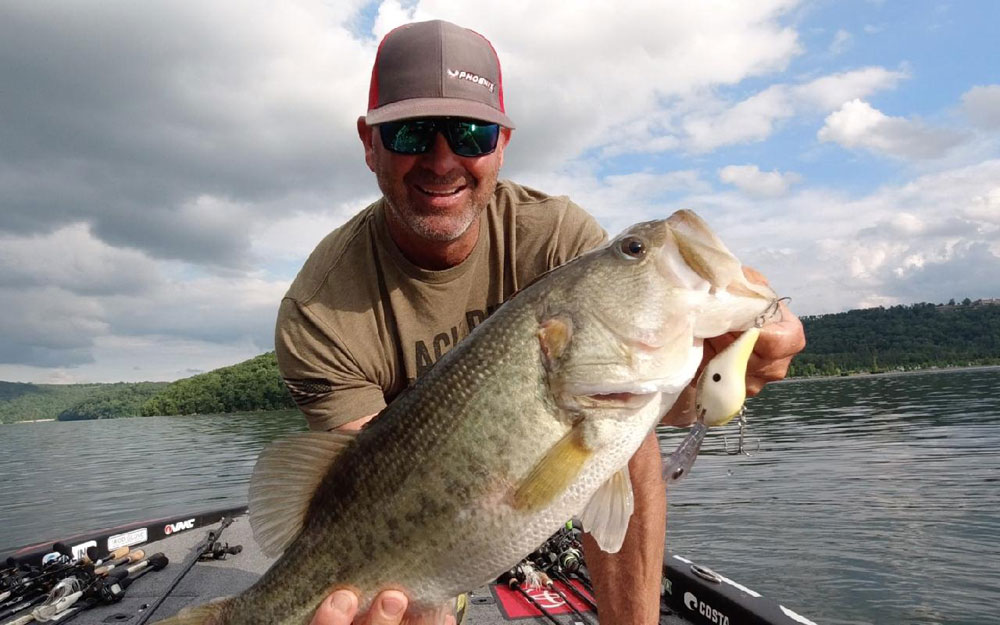provided by John Phillips
Gerald Swindle of Guntersville, Alabama, has been competitively bass fishing for 23 years. Before becoming a bass-fishing pro, Swindle was a carpenter. Because of his love of fishing, anytime there was a rain front coming, he dragged his boat with him to work. If he got laid off because of the weather, he put his rainsuit on, went to Smith Lake and fished all day in the rain. Sometimes, when he’d get off in the afternoon, he’d go home, hook up his boat and fish all night. If there ever was a fishing addict, Swindle fits that term. Because of his dedication and prowess in the sport, he went on to become a professional fisherman on the Bassmaster Elite and Major League Fishing circuits. He’s won the title of Bassmaster Angler of the Year twice (2004 & 2016). Whenever Swindle isn’t fishing one of those professional tours, he’s searching for any tournament in which he can compete. Gerald goes by the nickname GMAN, and he’s as entertaining as he is knowledgeable. To learn more about Swindle, visit his Facebook page. In Alabama, the summer temperatures often break the 100-degree mark. Mossy Oak asked how he finds bass and catches them under these extreme conditions.

One of the biggest problems that many anglers face when fishing deep is they get a big bass on and can’t bring it to the boat, because often there’s such a distance between the boat and the bass. So, the first thing I do when I catch a bass that’s 20-feet deep is I reel, reel, reel. You’ve got to keep pressure on those hooks to make sure they stay in the bass’s mouth. Often, when you hook a bass deep, it will try to come to the surface as fast as it can, and can reach the surface faster than you can reel. I stay ahead of the bass as it comes up and keep my line tight.
To be honest, you can’t keep a bass from jumping. I keep my rod pointed down at the water, but I don’t attempt to put my rod down under the water when I’ve got on a bass. I’ve found that if I put enough pressure on a bass by constantly reeling, then when it comes up, instead of jumping straight up, the fish will be coming toward me. Many anglers will panic when the bass comes up, and when they do, they’ll stop reeling. But I set the hook and never stop reeling until I jump the bass into the boat, or I reach down and get it by the lip or under the belly and put it in the boat. I fish Lew’s 6.8:1 reels and have a PHX Phoenix Bass Boat.
I think most anglers play around with the bass they hook too much when they get them close to the boat. When the fish comes up, I’ll lift it in to the boat with my rod, if the bass doesn’t weigh more than 4 pounds. However, if that bass is bigger than 4 pounds, I want to be down in my boat. The first time that bass comes within grabbing distance, I’ll grab its mouth. The more you walk around the boat and try to “play the fish down” as some anglers say before you try to land it, the greater your odds are of losing the bass.
As soon as I can see the fish and get my hands on it, I’ll grab it. One of the reasons bass fishermen tend to be a little hesitant to grab a bass in the mouth when its got three sets of treble hooks in its mouth is because they’re afraid of getting a hook in their hands. I’ve learned I can pull the hooks out of my hand if I get hooked.
My wife tells me, “Gerald, you need to have hands like an eagle’s feet. You reach in there and grab the bass by the jaw, and when you get hooks in your hand, you know how to pull them out.”
A big bass means money to me, so I don’t hesitate to stick my hand in a bass’s mouth, even knowing there are three sets of treble hooks in there that may stick me.






























